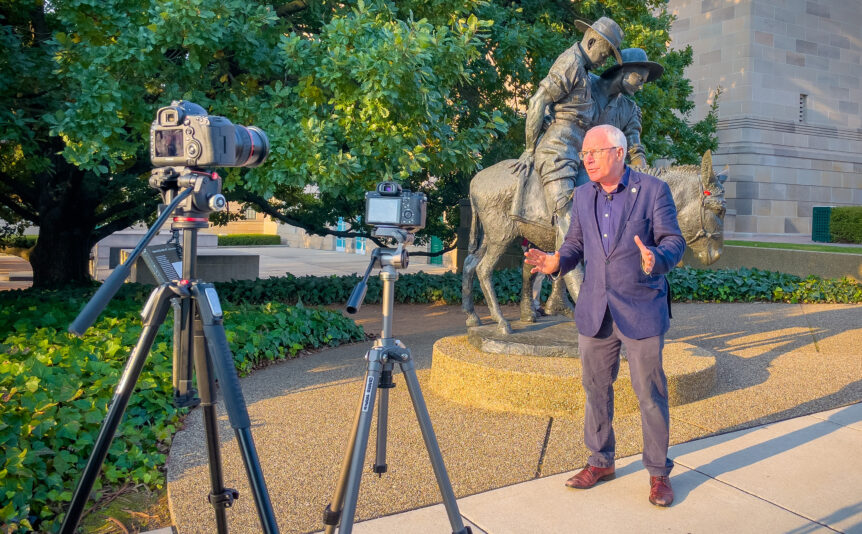Early Anzac Day services were disrupted by the ‘Spanish flu’ – a contagion that claimed more lives than the First World War. A hundred years on, a second great pandemic saw the virtual suspension of Anzac Day. The ANU responded by launching the Anzac Day Broadcast, a virtual commemoration and a reckoning with history as well.
The ANU Anzac Day Broadcast has just entered its fourth year [view this 2023 broadcast below]. It began in the early days of the pandemic, within weeks of the university closing its doors, and the very first broadcast suggests all the challenges of working remotely with what was then an unfamiliar medium. Even so, the program succeeded in connecting communities at a time when public gatherings were prohibited, and offered a chance to reflect – collectively and individually – on the loss and tragedy of war. It was also designed as a teaching exercise. From the outset, we reached out to leading scholars in the field of commemoration. [View 2020 and 2021 broadcasts at the end of this article]
Accordingly, the second Anzac Day Broadcast involved an extended conversation with Yale historian Jay Winter. It raised challenging issues about the personal and public dimensions of loss and mourning and considered what we forget when we remember war. Every part of that conversation was carefully compartmentalised. It became a resource, one easily delivered to students in ‘sound bites’, and it enriched teaching offerings impoverished by zoom. I’ve been heartened by how enthusiastically these programs have been received by my colleagues, especially those working in universities overseas. During the enforced isolation of the pandemic, it allowed teaching and learning communities to strike up a dialogue with one. another.
‘Sound bites’ may give quite the wrong idea about the broadcasts. A strong visual narrative drives each of the programs and allows the viewer to glimpse the world as others saw it. We turn the pages of a photograph album kept by an Australian nurse serving overseas, transporting the viewer from one location to another, lines across a map circle the globe, conveying the sheer scale of her journey, while drone flights above the picturesque cities Sister Hobbes visited convey her breathless wonder at the ancient world. Aligning image to spoken word is one of the great challenges of working with this medium. But so too is fidelity to history. While there is some latitude in how imagery is used, it’s important not to lift a picture (or a quote for that matter) out of its context. Anachronism is abhorrent to historians – and ‘cinematic story-telling’, if it’s to be a valuable teaching resource – has to withstand the same kind of scrutiny of rigorous peer review.
I’ve experimented with several formats for broadcasts. The interview technique works well, but its heavily reliant on the expertise and enthusiasm of the scholar interviewed. As with the most conventional class, preparation builds the foundation of effective teaching. There was some attempt to structure the conversation before we began. Every interview is an act of collaboration and it was important to agree on what should be asked and when. But to my mind the most exciting part of the narrative was when that discussion took an unexpected turn. A conversation seldom holds an audience when its scripted. The most valuable insights are infused with the spirit of discovery; they take the interviewer (and sometimes the interviewee) by surprise.

As the pandemic eased, I was able to set the broadcasts outside the boundaries of the classroom. ‘The Hidden Toll’ [below] examined the contentious topic of soldier suicide. It was filmed in the evocative spaces of the Australian War Memorial: the Hall of Memory with its poppy laden names, the reflection pool and the eternal flame. In a little over 20 minutes, we tried to convey the story behind each of those ‘nameless names’. ‘We’ suggests a partnership. It was a privilege to co-present this program with Alex McCosker, a prize-winning teacher and PhD candidate in the School of History. Working with ECRs, and our colleagues in the Centre for Teaching and Learning and CASS Marketing and Communications, reminded me again that the best teaching isn’t the single authoritative voice, but a genuinely collaborative endeavour.
The broadcasts are about teaching, but they are also a valuable form of community outreach. With the help of our Advancement Office, we have sent links to the broadcasts to ANU alumni across the globe, affirming their place in a community of scholarship and lifelong learning. They have been used by school teachers determined to add depth and complexity to an often restrictive school syllabus.
And messages of thanks and affirmation have flooded in from near and far – from the former director of ‘In Flanders Fields Museum’ in Belgium: ‘you were able to illustrate how the complexities of human experience are never quite met by our “national remembrance” practices’, to one of our colleagues here in the Hancock Library at ANU. Clare told me how Sister Hobbes’s story rekindled an interest in Miss Tipping from her own family history. It alerted her to the significance of fragile material artefacts she first encountered as a child: a nursing scarf and apron, an antique compact and mirror, a trusty ‘steamer trunk’ that accompanied the intrepid Miss Tipping on active service overseas. ‘Hopefully more will come out of hearts and closets’, Clare wrote to me, ‘remembering the single forgotten women of all wars, with never a cenotaph or wall bearing their names’.
May 2023
Professor Bruce Scates is based in the School of History. He is the writer and director of ‘Australian Journey’, and co-creator of the One Hundred Stories Project. The 2022 broadcast was directed by Adam Spence and the 2023 broadcast was directed by Rafael Florez.





